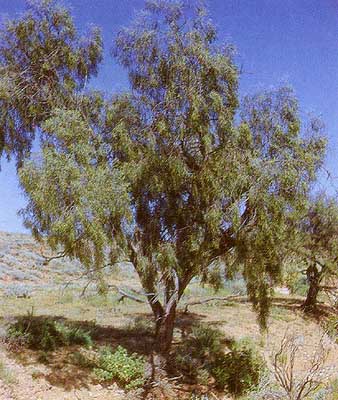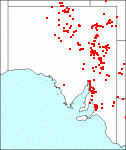Family: Fabaceae
Acacia salicina

Citation:
J. Lindley in Mitch., Three Exped. E. Aust. 2:20 (1838).
Derivation: salicina-derived from the plant name Salix (L.)—willow.
Synonymy: A. varians Benth. in Mitch., J. Exped. Int. Trop. Aust. 132 (1848). A. salicina Lindley var. varians (Benth.)Benth., Fl. Aust. 2:367 (1864); Racosperma salicinum (Lindl.)Pedley, Austrobaileya 2:355 (1987).
Common name: Broughton willow, native willow
Description:
Tall shrubs or small trees 3-6 m high with distinctive long drooping branchlets and pendulous blue-green phyllodes; branchlets slightly angular with a smooth grey bark; bark at the base hard, rough, grey-brown and fissured, often found in groves due to suckering habit.
Phyllodes broad-linear or narrow-oblanceolate, obtuse or slightly acuminate, 4-12 cm long, 4-20 mm broad, flat more or less flaccid, pendulous, 1 central vein, lateral veins numerous obscure; glands small 1 at the apexand usually 1-3 scattered along the upper margin.
Inflorescences axillary and solitary or mostly in racemes which are usually shorter than phyllodes consisting of 2-6 rather distant heads, sometimes appearing paniculate towards the ends of the branchlets; flower-heads globular, pale yellow, 15-25-flowered; flowers 5-merous.
Legumes narrowly oblong, 4-12 cm long c. 10 mm broad, flat or somewhat biconvex, thick woody; margins almost straight. Seeds longitudinal in legume; funicle thickened, usually scarlet, with 3-4 folds beneath the seed.
|
|
Distribution:
|
Gairdner-Torrens, Lake Eyre, Flinders Ranges, Eastern, Eyre Northern and Southern Lofty, and Murray regions. Generally associated with Eucalyptus camaldulensis in open woodland vegetation, or in tall open shrubland associated with other Acacia species along creek banks and flood plains. Soils, mainly grey cracking and self mulching clays, calcareous loamy, alkaline and neutral red duplex. Rainfall 125-500 mm Also N.T., Qld, N.S.W. and Vic.
S.Aust.: NW, LE, GT, FR, EA, EP, NL, MU, SL.
|
Flowering time: Irregular periods throughout the year.
|

SA Distribution Map based
on current data relating to
specimens held in the
State Herbarium of South Australia
|
Biology:
No text
Related taxa:
Acacia ligulata (sp. 45) is closely related, differing mainly in its habit being a bushy rounded dense shrub, its phyllodes thicker and more spreading and its smaller brittle legumes which are constricted between the seeds. Acacia ampliceps (W.Aust., N.T.) is also related.
Taxonomic notes:
Two mistletoes have been recorded on A. salicina in South Australia, of these Amyema preissii, wire-leaved is the most common, with a few specimens of Lysiana exocarpi, harlequin mistletoe.
A. salicina has timber with dark wavy markings and has been described as a rival to blackwood (A. melanoxylon). However inadequate supply and small size limit any large scale use of this wood.
For the results of seven pre-sowing treatments on germination see Aveyard (1968).
Everist (1981) records stock poisoning by A. salicina believing the toxic substances to be tannins and saponins.
The burnt ash of Acacia is added to the powdered leaf of pitjuri (Duboisia) before chewing by Aborigines. One of the favourite species burnt for this purpose is A. salicina. The alkali of the ash liberates an alkaloid from the crushed pitjuri leaves in the presence of saliva, Basedow (1925).
Cultivation:
A useful ornamental for shade and shelter planting in semi-arid or arid areas. The suckering habit can be useful for soil conservation; does best along creek and river flats. Fast growth rate.
Author:
Not yet available
Source:

|

